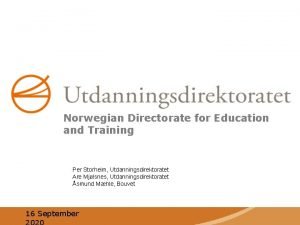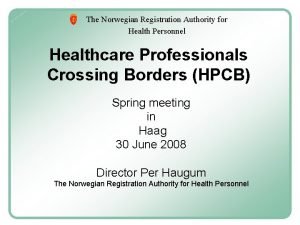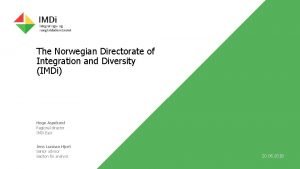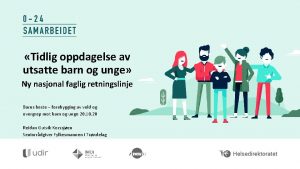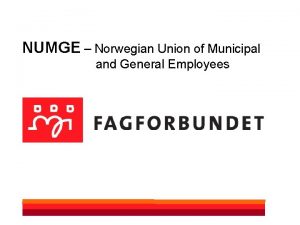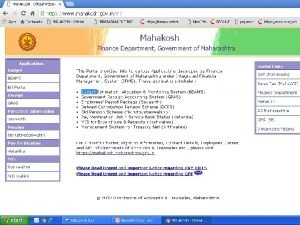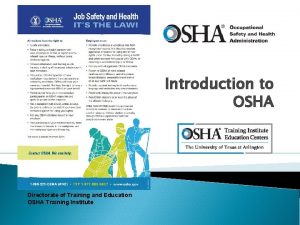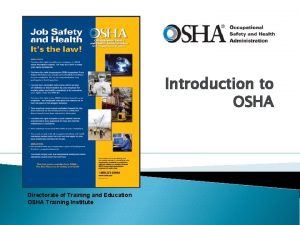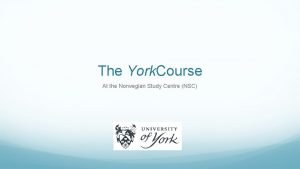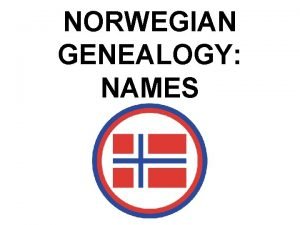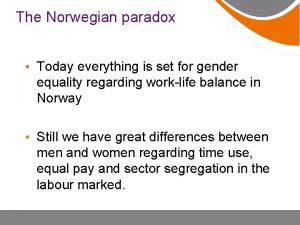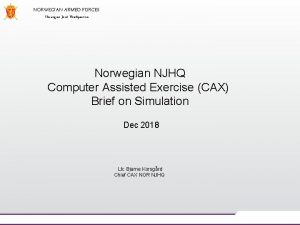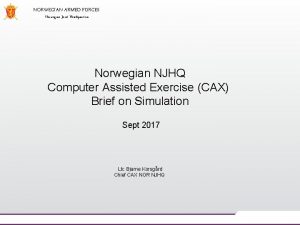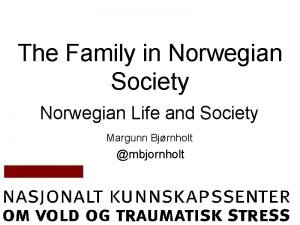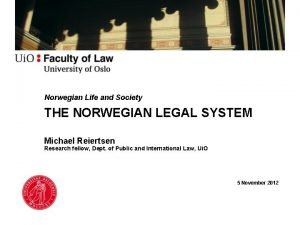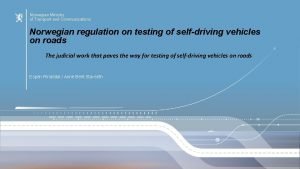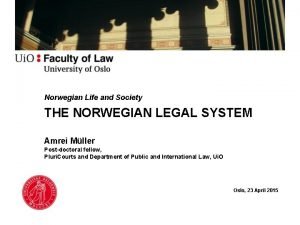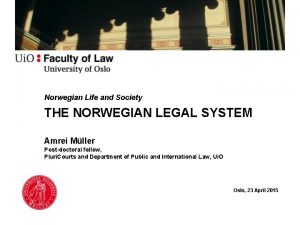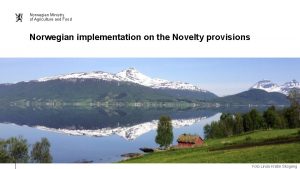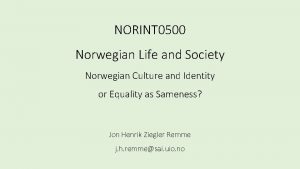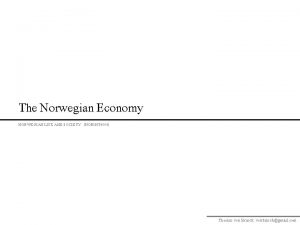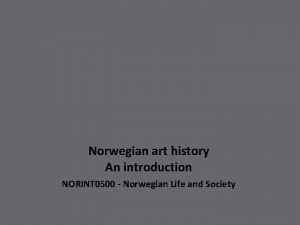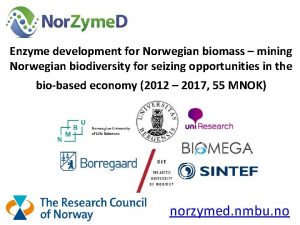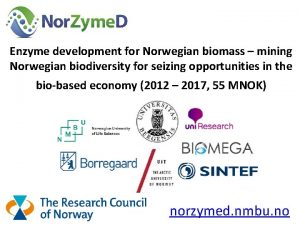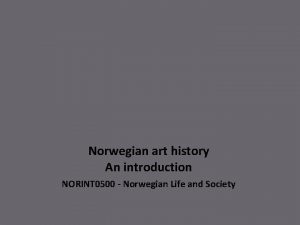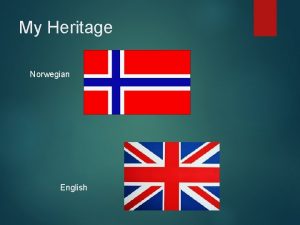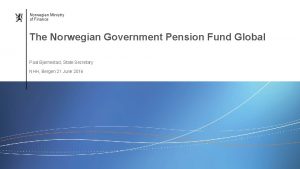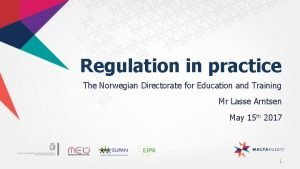The Norwegian Directorate of Integration and Diversity IMDi























- Slides: 23

The Norwegian Directorate of Integration and Diversity (IMDi) Hege Aspelund Regional director IMDi East Jens Lunnan Hjort Senior advisor Section for analysis 20. 06. 2018

The Directorate of Integration and Diversity (IMDi) Responsible for implementing the Norwegian Government’s integration policy. Separated out from the Directorate of Immigration (UDI) in 2006. UDI are responsible for the asylum procedure – IMDi are responsible once asylum has been granted. Under the jurisdiction of the Ministry of Education and Research (KD) from 2018. Previously (2016 -2018) under the jurisdiction of the Ministry of Justice and Public Security (JD).

Directorate of Integration and Diversity (IMDi) Budget 2018: approx. € 31 million Administers grants in 2018 for approx. € 1, 8 billion 235 employees 6 regional offices

Central tasks Settling refugees in Norwegian municipalities Basic qualification of refugees through the Introductory Program Administering financial grants to municipalities and voluntary organizations National authority for supervising interpreting services in the public sector Coordinating a cross-sectional strategy against negative social control Develop expertise and contribute to a knowledge-based integration policy

Collaborators Municipalities Ministry of Education & Research (KD) - Department of Integration (INA) Other directorates: Immigration (UDI), Adult Education (Skills Norway), Labor & Welfare (AVdir), Education (Udir), Children, Youth & Family Affairs (Bufdir), Health (Hdir), Housing (Husbanken) Voluntary organizations Integration is not a separate sector responsibility. IMDi aims to be a link between various actors who must work together to succeed.

Immigrants as share of population, 2017 Norwegian-born children of immigrants: 159 000 (3%) Majority population: 4 366 000 (83%) Immigrants: 725 000 (14%)

Countries of origin (1. 1. 2017) 1. Poland 2. Lithuania 3. Sweden 4. Somalia 5. Germany 6. Iraq 7. Syria 8. Philippines 9. Pakistan 10. Eritrea 97 37 36 28 24 22 20 20 19 19 196 638 315 696 601 493 823 537 973 957

Reason for immigration (1990 -2017) 6% 30% 28% Refugees & their family reunited Labor migrants Other family migrants Students & au pairs 37%

Applications for asylum, 2007 -2017 35, 000 31, 150 30, 000 25, 000 20, 000 17, 226 14, 431 15, 000 11, 983 10, 064 10, 000 9, 053 11, 480 9, 785 6, 528 5, 000 3, 460 3, 560 2016 2017 2008 2009 2010 2011 2012 2013 2014 2015

Percentage employed (age 15 -74), 1. 1. 2017 80 74. 8 66. 9 70 58. 9 60 50 46. 5 40 30 20 10 0 Refugees & their family reunited Other family migrants Natives Labor migrants

Percentage registered unemployed, 2018 12 10 8 7. 1 6. 4 6. 1 5. 5 6 4 3. 4 2. 5 2. 4 2. 9 1. 8 2 0 Total Natives All immigrants Nordic Western Europe Eastern Europe North America EU non-EU & Oceania Asia Africa Latin America

Barriers to labor market participation for immigrants Language barrier Many immigrants arrive with few educational credentials Decreasing number of «low-skill» jobs Female immigrants often have fewer credentials, less work experience, & more care-giving burdens Employers may not trust foreign credentials Discrimination Immigrants often among the first to lose their jobs in downsizing processes Jobs available to immigrants may be insecure, not full-time, manual & strenuous Welfare state, safety net measures may soften the incentive to work

Integration through labor market participation Sustained emphasis, prioritized objective Introduction Act, 2003 White paper (Meld. St. 30 (2015 -2016)): From Reception Center to the Labor Market – An Effective Integration Policy Official Norwegian Report (NOU 2017: 2): Integration and Trust – Long-term Consequences of High Immigration

IMDi measures promoting employment among immigrants The Introductory Program Language training The Job Opportunity Program Grants for mentoring, traineeship & entrepreneurship programs for immigrants Free core hours in kindergarten «Integration Reception Center» pilot Advocating & facilitating employer involvement

The Introductory Program Newly arrived refugees (and their family reunited) between ages 18 and 55 Full-time program over two years, with the option of a third year Norwegian language and civics tuition, additional qualification measures, career counseling Individual plan, individual program advisor Participation is tied to a benefit of approx. € 1 600 per month

Introductory Program participants at start of year, 2008 -2020 25000 23700 20000 18500 18148 15000 12825 10198 9673 10000 10907 10841 2014 2015 11000 8513 8019 6529 5000 0 2009 2010 2011 2012 2013 2016 2017 2018 2019 2020

The Introductory Program Municipalities receive an integration grant from IMDi tied to each refugee, that runs over 5 years: Year 1 -2: approx. € 25 000. Year 3: approx. € 18 000. Year 4 -5: approx. € 8 000. Municipalities are responsible for how the program is anchored and organized locally IMDi provides guidance, arranges seminars & workshops, provides links with employers & voluntary sector, monitors results National ambition: 70 per cent in employment or education 1 year after program completion

Percentage in work or education 1 year after program 80 70 69 61 60 53 71 63 72 70 71 66 62 62 58 53 52 61 50 49 49 2014 2015 2016 50 40 30 20 10 0 2011 2012 2013 Total Women Men

Large local variations. Success factors: Formal education as part of IP Cooperation between municipal agencies Job training as part of IP Cooperation with voluntary sector Qualified teachers Cooperation with employers Municipal leadership emphasizes results Availability of jobs and internships

The Job Opportunity Program ( «Jobbsjansen del A» ) Immigrant women age 18 -55 who after several years in Norway have little connection to paid work Full-time qualification program based on the introductory program model Budget: Approx. € 6 million Approx. 750 participants per year Approx. 70 per cent of participants make a direct transition to work or education

Employment over time The percentage of refugees in employment rises during the first few years after settlement, But after 5 -7 years tends to decrease among men, And stagnate at a low level among women. There may be a conflict between the aim of rapid employment and long-term self-sufficiency.

Invest in qualification Refugees who obtain formal education in Norway are much more likely to be employed Investing in education pays off, even if it may take several years A step-by-step, linear model is not ideal – combine education & work training if possible

Thank you! hea@imdi. no jlh@imdi. no
 Norwegian directorate for education and training
Norwegian directorate for education and training Norwegian registration authority for health personnel
Norwegian registration authority for health personnel Imdi norway
Imdi norway Imdi
Imdi What is ecosystem biodiversity
What is ecosystem biodiversity Ecosystem jigsaw activity
Ecosystem jigsaw activity Norwegian union of municipal and general employees
Norwegian union of municipal and general employees Norwegian museum of science and technology
Norwegian museum of science and technology Forward integration and backward integration
Forward integration and backward integration Backwards intergration
Backwards intergration Simultaneous integration
Simultaneous integration Early childhood education and care directorate
Early childhood education and care directorate Dhs s&t org chart
Dhs s&t org chart General directorate of animal health and production
General directorate of animal health and production Osha directorate of training and education
Osha directorate of training and education Directorate of treasuries
Directorate of treasuries Osha directorate of training and education
Osha directorate of training and education Osha directorate of training and education
Osha directorate of training and education Air force research laboratory logo
Air force research laboratory logo Rem module york
Rem module york Norwegian police university college
Norwegian police university college Norwegian naming conventions
Norwegian naming conventions Occluded front
Occluded front Norwegian paradox
Norwegian paradox
